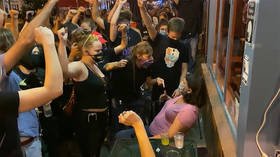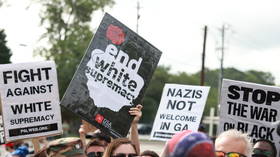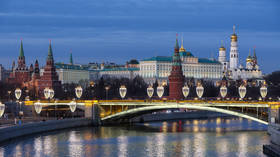Black Lives Matter is a noble cause, but harassment, coercion and bullying won’t advance it - it’ll just make the 'brand' toxic

Viral videos have emerged this week of Black Lives Matter activists abusing individuals for not ‘raising a fist’. BLM is a needed and noble cause, but incidents of intimidation and harassment will do it nothing but harm.
There’s a saying that goes, “a bad apple spoils the bunch.” Sometimes “bunch” is replaced by “barrel,” but that’s not really important right now. It’s one of the most depressing phrases in the English language, because it means some idiot or idiots are ruining something good that they’re part of.
Which brings me to a couple of videos that have spread rapidly across social and mainstream media this week. They show groups of Black Lives Matter supporters verbally haranguing and physically intimidating people who refuse to ‘raise a fist’ in solidarity with the cause. One of these, a woman, is reportedly a BLM supporter who has been on marches against racism and police brutality.
1) In a scene that played out several times Monday, a Black Lives Matter protest that began in Columbia Heights confronted White diners outside D.C. restaurants, chanting “White silence is violence!” and demanding White diners show their solidarity. #DCProtestspic.twitter.com/fJbPM76vb0
— Fredrick Kunkle WaPo (@KunkleFredrick) August 25, 2020
I need to make two things clear before I get to my point:
I think Black Lives Matter is a much-needed and noble cause.
The people doing the harassing are dicks.
It is actually possible for one person to hold these two views simultaneously, though you wouldn’t think so amid the absolutist universe of online discourse. It’s like people thinking that having a police force is generally a good thing, but that those police officers harassing, beating and, of course, murdering innocent people – particularly when it’s based on the colour of their skin – are a blight on humanity.
I think the people in those videos are dicks for a number of reasons. First, it’s clearly dickish behaviour to gang up on someone and chant or shout in their face because they won’t do what you want them to. It’s bullying, which is one of the things they’re supposed to be fighting against.
Secondly, it doesn’t work. You can’t change someone’s mind through coercion. You might change their behaviour because they’re frightened, but you won’t alter their views – at least, not in the way you’d like to. It’s like training a dog by beating it with a stick; it still wants to bark or jump up, it’s just petrified of what will happen if it does.
You can only change minds through education and conversation. Or, in the case of the dog, roast chicken.
But perhaps the most depressing element is the damage bad apples do to people’s perceptions. I hate to say it, but we live in an age where ‘brand’ is king, and perceptions of brands are heavily influenced by mainstream and social media.
I don’t buy the notion of Black Lives Matter as an organisation. It’s a slogan that represents an idea. There is an organisation with that name, of course, but it’s not some all-powerful activist network manipulating the millions of BLM protesters around the world – no matter what some people try to tell you.
However, even as a slogan, as an idea, Black Lives Matter still has a ‘brand’. And like any brand, it can be tarnished, become toxic.
Our world is image-led, and the most impactful images are the ones that get noticed, get remembered and get splashed across all forms of media. From online alt-right agitators to ‘progressive’ campaigners and mainstream newspapers, they’ll always share the juiciest, most clicky content.
And it doesn’t matter if these images aren’t representative; they will alter perceptions – and they will be used to alter perceptions. In the aftermath of George Floyd’s murder, the vast majority of protests were peaceful, but people with an anti-BLM agenda (which often translates as an anti-black agenda) used footage of an idiot minority looting and rioting to make it look very different, sharing it with comments like “so-called peaceful protest.”
People don’t even have to have an agenda for this stuff to affect how a movement, organisation or person is perceived. They’ll share it because it’s what they’re most likely to see. Because it’s what everyone is sharing.
This is why the people in those videos are dicks. Not just because of their actions, but because they fail to realise the consequences of those actions.
I’m all for civil disobedience. I’m all for protest. I understand the rage in some people. Many actions are forgivable. But acting like this plays into the hands of critics – into the hands of racists – by making the BLM ‘brand’ toxic in the eyes of people who can’t, or don’t want to, see the bigger picture. Rightfully or wrongfully, it gives them an ‘out’ to use. You see it everywhere: “I did have sympathy, but after seeing these videos, I don’t.”
Yes, that’s a bit pathetic, but it’s the way things are. Castigating people in the street, and more importantly on camera, isn’t a recruitment tool – it’s a PR disaster. If enough bad apples end up on enough screens, people will be turned off and a good cause will be harmed.
And this cause can’t afford for that to happen.
Think your friends would be interested? Share this story!
The statements, views and opinions expressed in this column are solely those of the author and do not necessarily represent those of RT.


















